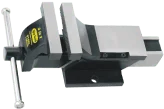Bench vises are crucial tools in both professional and DIY settings, providing the stability and precision needed for many different projects. While often confused with clamps, they offer numerous benefits when used properly.
In this blog, we’ll explore everything you need to know about bench vises, including their functions, applications, and the importance of weight in a bench vise.
What are the uses of a bench vice?
A bench vise is a must-have tool for any workshop or garage, offering a versatile solution for securely clamping and holding workpieces in place during a variety of tasks. Whether you’re an experienced pro or a DIY enthusiast, knowing the key details about a bench vice can greatly improve both your efficiency and safety.
- Clamping Workpieces: A bench vice securely holds materials like wood, metal, plastic, or pipes in place, allowing you to cut, drill, saw, or file without the material slipping.
- Cutting and Shaping: Whether you’re cutting metal, shaping wood, or grinding, the vice keeps the workpiece steady, ensuring precision and safety during the process.
- Drilling: The vice can hold workpieces while drilling, keeping them stable and minimizing the risk of injury or inaccurate drilling.
- Soldering and Welding: It provides a steady grip on parts when soldering or welding, preventing movement and improving accuracy.
- Bending and Straightening: A bench vice can be used to bend or straighten materials like rods and pipes with controlled force.
- Assembly and Disassembly: The vice can hold parts together for assembly or disassembly, which is especially useful for projects involving small parts or mechanical components.
Why does the weight of a bench vise matter?
The weight of a bench vice matters because it ensures clamping power and stability, which means if you have a heavy bench vice, you are likely to perform heavy-duty tasks. Heavy-duty bench clamp vise ensures better-holding strength, preventing slippage when applying pressure to a workpiece. This is ideal for heavy-duty tasks like planing, sawing, or clamping large workpieces of materials.
- Stability: More weight on a bench vice means better stability and grip on the workbench, preventing a bench vice from moving when clamping pressure is applied.
- Holding power: Heavier bench vises are often manufactured with high-quality materials and components, which can endure heavy-duty tasks with greater clamping strength.
- Ideal for larger workpieces: For heavier or larger workpieces, a heavy-duty bench vice is crucial to securely hold them in place. Many bench vices have built-in blacksmith anvil with sturdy surfaces to perform different tasks.
- Applications: If you are looking to perform heavy-duty tasks like metalworking, it’s essential to consider the weight of a bench vice.
What to consider when choosing a bench vice?
When buying a bench vice, you need to pay attention to a few things to ensure the vice you are buying is the right one. Make sure to consider jaw width to accommodate the object’s size you need to clamp, throat depth, clamping pressure, mounting type (fixed or swivel), and type of material used to manufacture a bench vise.
- Size of the jaw: The jaw width determines the maximum size of the object you are looking to clamp.
- Throat depth: The distance from the top of the jaws to the back of the bench vise is called throat depth, which is important for holding larger workpieces with wider dimensions.
- Clamping force: How much the vice can exert clamping force, which is crucial for holding objects securely during work.
- Mounting type: Make sure to check whether the bench vice has a fixed or swivel base for flexibility.
- Material: Don’t forget to check the material used to manufacture a bench vise. Material quality matters a lot. Cast iron is the most commonly used material due to its durability and strength.
Conclusion
Weight is one of the most crucial factors that you must consider when buying a bench vise. Despite this, make sure to consider other factors to ensure you are choosing the right bench vice for your work. You can also explore different types of bench vices at Ajay Tools along with their price list.


